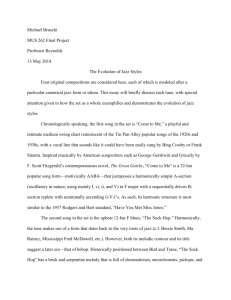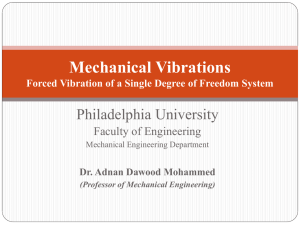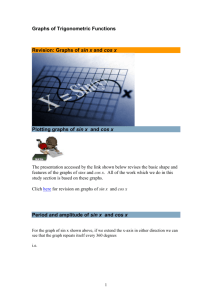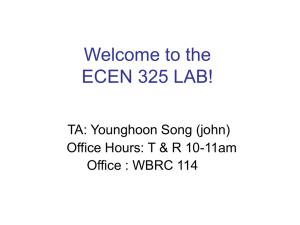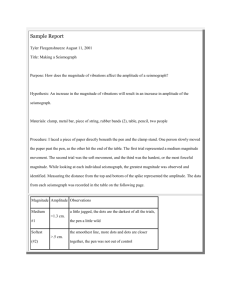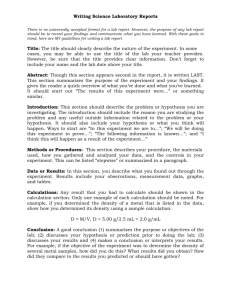ME495_Chapter5_Lecture5
advertisement
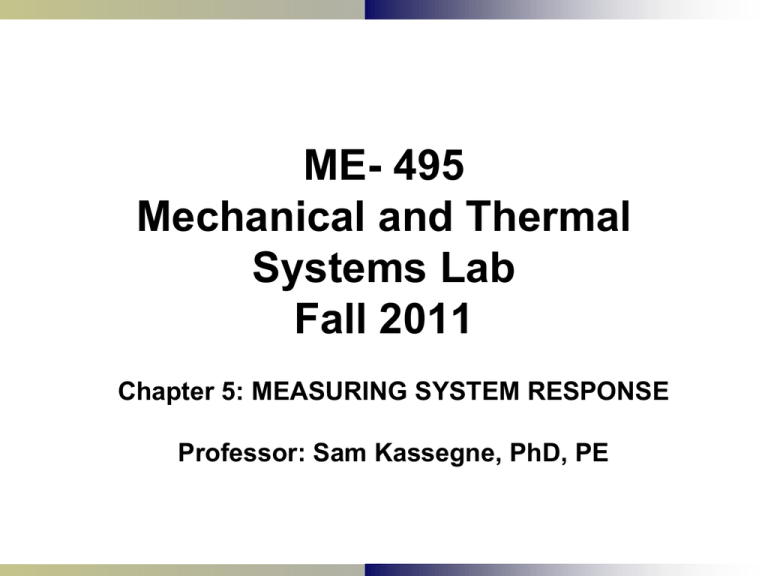
ME- 495 Mechanical and Thermal Systems Lab Fall 2011 Chapter 5: MEASURING SYSTEM RESPONSE Professor: Sam Kassegne, PhD, PE Signal Response of Measurand? RESPONSE • System Response: an evaluation of the systems ability to faithfully sense, transmit and present all pertinent information included in the measurand and exclude all else: • Key response characteristics/components are: – – – – Amplitude response Frequency response Phase response Slew Rate COMPONENTS OF SYSTEM RESPONSE 1) Amplitude response: • ability to treat all input amplitudes uniformly – Overdriving – exceeding an amplifiers ability to maintain consistent proportional output – Gain = Amplification = So/Si – Smin<Si<Smax Overloaded in this range. COMPONENTS OF SYSTEM RESPONSE 2) Frequency Response • ability to measure all frequency components proportionally • Attenuation: loss of signal frequencies over a specific range Attenuated in this range. COMPONENTS OF SYSTEM RESPONSE 3) Phase Response • amplifiers ability to maintain the phase relationships in a complex wave. • This is usually important for complex waves unlike amplitude and frequency responses which are important for all types of input wave forms. Why? COMPONENTS OF SYSTEM RESPONSE • 4) Delay/Rise time: time delay between start of step but before proper output magnitude is reached. • Slew rate: maximum rate of change that the system can handle (de/dt) (i.e. for example 25 volts/microsecond) Dynamic Characteristics of Simplified Mechanical Systems Generalized Equation of Motion for a Spring Mass Damper System(1-axis) • F(t) = general excitation force • = fundamental circular forcing frequency 1 d 2s ds F(t ) m 2 Ks g c dt dt Ao F( t ) Cn cos(nt n ) 2 n 1 C n An Bn 2 tan Bn An 2 (I)FIRST ORDER SYSTEM (I.A) Step Forced If mass = 0, we get a first-order system. E.g. Temperature sensing systems • F(t)=0 for t<0 • F(t) = F0 for t >= 0 – t=time, k=deflection constant – s=displacement, =damping coefficient – Fo=amplitude of input force • This can be reduced to the general form: (after integration over time and simplification) – – – – ds F( t ) ks dt t P P PA P e P=magnitude of any first order system at time t P=limiting magnitude of the process as t PA=initial magnitude of process at t=0 = time constant = /k The above equation could be used to define processes such as a heated/cooled bulk or mass, such as temperature sensor subjected to a step-temperature change, simple capacitive-resistive or inductive-resistive circuits, and the decay of a radioactive source. Figure (a) depicts progressive process Figure (b) depicts decaying process (I)FIRST ORDER SYSTEM (I.B) Harmonically Excited ds F( t ) ks dt 1 P G (f ) d Ps F(t) = Fo cost 1 ( 2f) 2 Pd m axim u m_ am pl itu de_ of _ th e_ pe riodic_ dyn am ic_ proce ss Ps stati c_ displace mne t _ of _ F Fo k 1 T ti m e_ con stant k ph ase_ re spon se_ be com e s: _ (f ) tan1 ( 2f) ide al ly_ G 1 _ an d_ 0 _& _ work s_ as _ 2f 1 f fre qu e n cy ( Hz) PHASE LAG First Order System – Harmonically Excited – Example Temperature Probe Example TEMPERATURE PROBE EXAMPLE - Continued TEMPERATURE PROBE EXAMPLE - Continued (II) SECOND ORDER SYSTEM (II.A) Step Input 1 F (t ) gc d 2 s ds m Ks 2 dt dt • Step input – F=0 when t<0 – F=Fo when t>0 • Underdamped Eq: OVERDAMPED SECOND ORDER SYSTEM • = / C >1 This represents both damped and under-damped cases. (II) SECOND ORDER SYSTEM (II.B) Harmonically Excited F(t) = Fo cost Second Order System – Harmonically Excited Example Microphone Example MICROPHONE EXAMPLE MICROPHONE EXAMPLE

